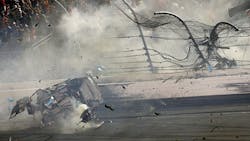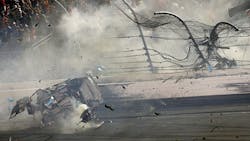In the EHS world, we repeatedly make the case for safety.
We devise handbooks.
We create training courses.
We mandate it through rules and regulations.
Yet, the real importance of safety is never more apparent than after an accident.
Early Monday morning, NASCAR fans watched as Austin Dillon’s No. 3 car crashed into the catchfence at the Daytona International Speedway, being “caught like a baseball in a glove,” as my dad, who watched the event as it unraveled, said.
The catchfence seemingly did its job by keeping the race car out of the grandstand.
And, while the car, a Chevrolet SS, was torn apart after being propelled into the fence during the final lap of the Coke Zero 400, its driver walked away relatively unscathed.
“But just thank the good Lord for taking care of me and for what NASCAR has done to make the sport this much safer. I just hope everybody in the stands is all right,” Dillon told NASCAR after the wreck.
“But I just think the next thing is that we are going to have to make this racing even more safe. We are running 200 mph and pushing each other around out there and it's just bound to happen. No matter how safe we can make the sport, when you are going that amount of speed, things happen.”
The fans struck by debris from the car escaped with minor injuries, according to reports.
After the race, NASCAR Chairman and CEO Brian France said the work to making racing safer for fans and drivers never ends.
“We’re working on better solutions all the time to make racing safer and better,” France said.
But the fact that Dillon and the fans escaped the ghastly wreck without serious injuries is a testament to the steps NASCAR has taken to make the injury-prone sport safer.
As part of the Daytona Rising redevelopment project at the speedway, fans were not seated in the front row of the stands or along Rim Road, Daytona International Speedway track president Joie Chitwood III said.
About the Author
Ginger Christ Blog
Associate Editor
Ginger Christ is an associate editor for EHS Today, a Penton publication.
She has covered business news for the past seven years, working at daily and weekly newspapers and magazines in Ohio, including the Dayton Business Journal and Crain’s Cleveland Business.
Most recently, she covered transportation and leadership for IndustryWeek, a sister publication to EHS Today.
She holds a bachelor of arts in English and in Film Studies from the University of Pittsburgh.

